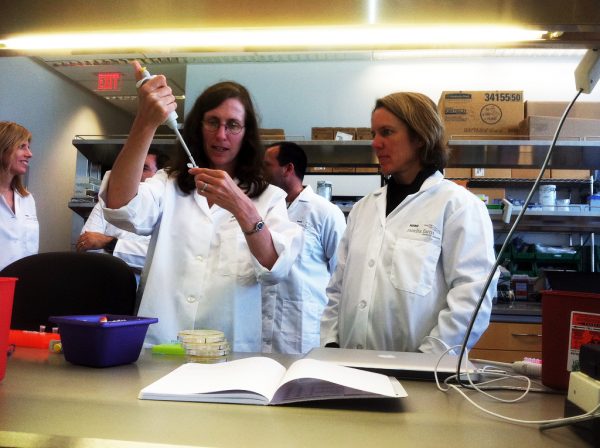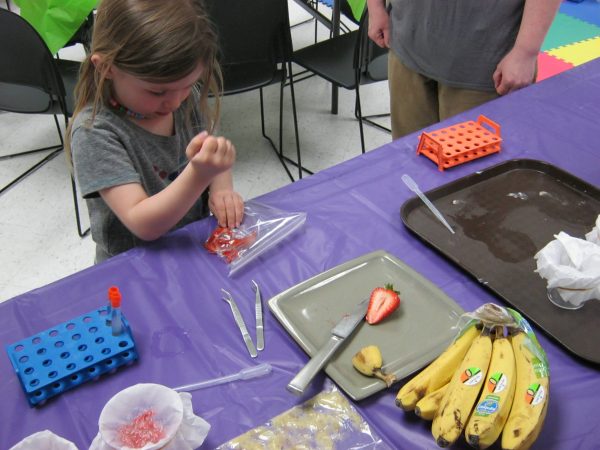Synthetic biology crosses scientific fields to solve problems
August 18, 2016
Theresa Bakker
907-474-6941

Imagine using science to make new living things. It might sound futuristic, but scientists are working toward solving a wide variety of problems in health, energy and the environment with innovations in synthetic biology. That's a field that applies engineering principles and mathematical modeling to design biological machines for useful purposes.
Scientists Elizabeth Allman and Kristin O’Brien teach a course in synthetic biology at the University of Alaska Fairbanks. They are teaming up with educators at the University of Alaska Museum of the North in August to present a program called Building with Biology. Participants will be able to talk with scientists and explore hands-on activities. There will be a DNA extraction station and the game Bio Bistro, which challenges participants to consider whether they would eat vanilla grown from yeast and other synthetic foods.
O’Brien is a fish physiologist with the UAF Institute of Arctic Biology. She said the goal of synthetic biology is not to build “better organisms” but rather to create biological machines. "By combining DNA sequences in new ways, we learn more about how genes function and how gene products interact in networks. What often emerges is that it is far more complex than we imagined.”
The DNA potential
At the root of this new scientific frontier is access to the building blocks of life, the genetic information stored in all DNA. This innovation also unlocks the knowledge of how things are related.
Allman, a professor at the UAF College of Natural Science and Mathematics, calls herself a “mathematician who works on biological problems.” She makes models to explore organic processes. Her research focuses on modeling DNA sequence evolution on trees through time. Modeling can also be applied to physiological processes, such as cardiac rhythms.
“You certainly want a model of an artificial heart or pacemaker before you go and put one in a live human," she said. "Modeling the effect of sending electric pulses into heart tissue can help predict how those regular artificially induced beats will play out in a living person or tissue.”
Allman said scientists in her field try to relate organisms by finding similarities and differences in DNA sequences. Many of the museum’s researchers also conduct phylogenetic studies to understand the connections among the world’s living things. For example, scientists now know that the Amazon rainforest hosts at least 12,000 different species of trees. A study published this summer relied on more than 500,000 digitized records from museum collections dating back to 1707. These included photos of fruits, flowers, and leaves stored on scientific aggregators like iDigBio.
Access to specimens is a priority for the curators at the UA Museum of the North. Herbarium Curator Steffi Ickert-Bond has focused on sharing data through a variety of web portals, like iDigBio. Almost 35 million UA Museum of the North records were accessed through those databases in the last fiscal year. She says biological museum collections may be one of our nation’s least known treasures.
“Scientists use these collections to study both ancient and newly evolved species and to track changes in distribution of life on Earth," she said. "This information is critical to the development of environmental, agricultural, economic and public health policies.”
Explore synthetic biology

All that genetic data has real potential for new innovations. Ickert-Bond said there are many examples where engineers have already borrowed from nature. The development of Velcro is based on the interlocking hairs of some plants, for example.
And museum educator Gabrielle Vance said visitors to the Museum of the North can explore the nexus of biology and engineering even further. “Visitors can learn about seal genetics research in the Gallery of Alaska. The galleries are also full of examples of Alaskans combining biology and engineering to survive in their environment, from harpoons and halibut hooks to intestine parkas."
The museum’s genomic resources and the Ancient DNA Laboratory is also an interesting stop on a behind-the-scenes tour. Here, genetic extractions can be sampled from a variety of specimens, even ice age mammal bones used by Alaska’s earliest people.
These are some of the surprising discoveries waiting to be made from combining expertise across specialties. O’Brien said much of the work of biological research is interdisciplinary. Yet it is often difficult for students to see the importance of math to understanding biology. “What I like to impress upon young, curious minds is that while we know a lot about biology, there is even more that we don’t know. The world is waiting for their discoveries!”
More to explore
The community is invited to a “Building with Biology” program from 12-3 p.m. Aug. 20 at the UA Museum of the North. Participants can meet scientists, design a super-organism and learn about DNA. Activities are included with admission. For more information, visit the museum's website at www.uaf.edu/museum or call 907-474-7505.


